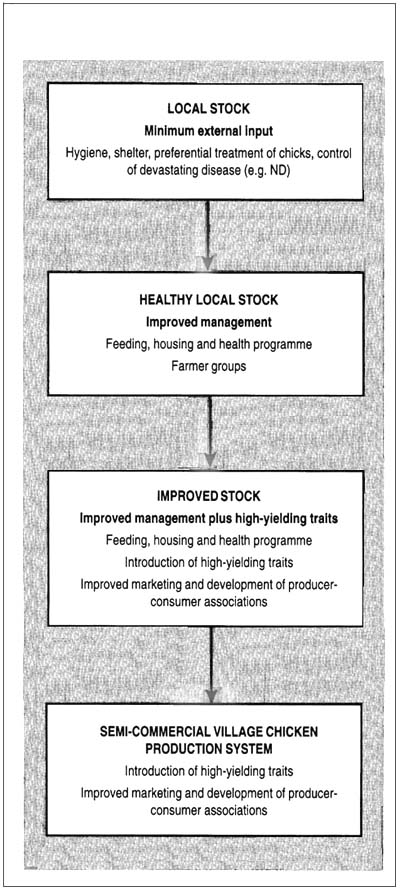Village chicken production systems have not been included in the mainstream agricultural and economic activities of most African countries. There is a paucity of quantitative data to support the importance of the village chicken production systems in household and national economies. There has been more development focused on introducing exotic high-yielding breeds than understanding the production potential of village chickens. Nevertheless, a new research focus on village chickens has developed in the last decade, and consequently there have been changes in objectives and development strategies.
Village chicken production systems are integrated in the rural farming systems, and therefore sustainable improvement programmes need to adopt a systems perspective. Achievements made in single-discipline-oriented programmes are not sustainable, as noted in the past improvement programmes. The FAO technical assistance programmes, as well as development programmes, have made a major impact - particularly in increasing awareness on the importance of this sector in household food security and welfare. However, these programmes were short term, and in most cases the local governments and beneficiary communities are not prepared to sustain the developments. The Newcastle disease vaccination programmes conducted in the case study countries give examples of this problem of continuity. Therefore, there is a need to develop a cross-checking mechanism within the technical assistance programmes that will ensure the continuity of activities to develop sustainable improvements. The inclusion of a household poultry element in FAO's SPFS creates an opportunity for technical assistance programmes for rural poultry. Furthermore, the multidisciplinary nature of the SPFS will allow for sharing and exchange of experiences among different divisions of FAO.
This study was based on the hypothesis that village chicken production systems of Africa form the basis for improved rural poultry and can be transformed from subsistence to semi-commercial production systems to increase food security and income, specifically among the disadvantaged members of the community. First, the predominance of local chickens in most countries, after more than five decades of introducing exotic genes, supports this hypothesis. The analytical presentation of the problem of low production of village chicken flocks (Figure 14) shows that substantial increases in egg production and chicken meat production can be attained through improved management and disease control to reduce the large number of bird losses. The experience of the rural poultry improvement programme in the Gambia and the semi-scavenging model for rural poultry in Bangladesh indicate that with an appropriate approach and technology, rural poultry can be transformed from a subsistence to a semi-commercial production system.
In view of the complex nature of the village chicken production systems, improvement technologies should be introduced using the farming systems approach. Step-wise improvements, suggested in the guidelines for inclusion of household poultry in the SPFS, provide the most integrated approach and should be vigorously pursued by both FAO and member countries. Four steps are suggested in Figure 21 to transform the village chicken production systems into semi-commercial production units.
The village chicken production systems are not homogenous: thus step I may not be the starting-point for every village or country. However, Newcastle disease, which is the major constraint identified by farmers, should be given priority at all stages. The following strategic measures for developing sustainable community-based ND control in village chickens are drawn from the present study.
Country epidemiological studies. More country epidemiological studies in village chickens should be undertaken to understand the host-pathogen-environment interactions. Results from such studies could be used in developing vaccination programmes, as well as selecting the most cost-effective vaccines.
ND vaccine production and quality control. There is a need for more coordinated research on the most appropriate and cost-effective vaccine for controlling ND in village chickens. The role of the Pan African Veterinary Vaccine Centre (PANVAC) in the harmonizing of ND and quality control need to be reviewed. The production of ND vaccines, particularly the heat-stable V4 vaccine, is not likely to be undertaken by national systems in the near future. Therefore, there is need for more national and international support on possible future production of the vaccine. PANVAC reopened in 1996, and should be supported to enable the centre to conduct independent quality control of the different vaccines used in the region.
Community-based ND control programmes. Community participation in ND control programmes is crucial to the development of sustainable control programmes. Farmer training using extension messages through the media, i.e. television, radio, newspapers and posters, should be part of ND control programmes, as is commonly practised in programmes for rinderpest eradication, contagious bovine pleuropneumonia, foot-and-mouth disease and rabies.
Networking. Networking should be encouraged in village chicken production. There is a need for more national support to the existing African Network for Rural Poultry Development (ANRPD). The network should endeavour to identify key or priority problems that would benefit from networking. Regional networks to control ND, similar to those of Southeast Asia, should be started and linked with the ANRPD. The FAO/ International Fund for Agricultural Development (IFAD) Regional Animal Disease Surveillance and Control Network for North Africa, the Near East and the Arabian Peninsula (RADISCON) has been launched (see http://www.fao.org/ WAICENT/Faolnfo/Agricult/AGA/AGAH/ Radiscon/Default.htm).
Production, feeding and harvesting of unconventional feed resources. Techniques for producing, harvesting and feeding of unconventional feed resources that have been tested on a small scale should be developed further to increase the scavenging feed resource base. Integrating chickens with cropping or gardening should be encouraged where conditions allow.
Farm structures. Appropriate farm structures, including housing, feeders, waterers, nests and cages for transportation should be developed. Designs that can be used to provide preferential treatment, such as feeding and vaccination, to birds of different ages should be encouraged.
In conclusion, the proposed development approaches and improvement technologies should be based on producer participation, particularly aimed at increasing management skills, product utilization and marketing. Incorporation of a gender variable in all rural poultry improvement programmes will increase resource-use efficiency and equal distribution of the benefits.
FIGURE 21
Step-wise improvement of the village chicken production systems
